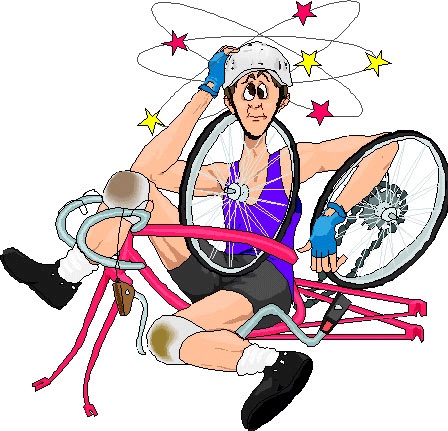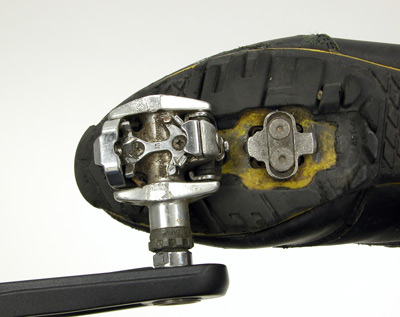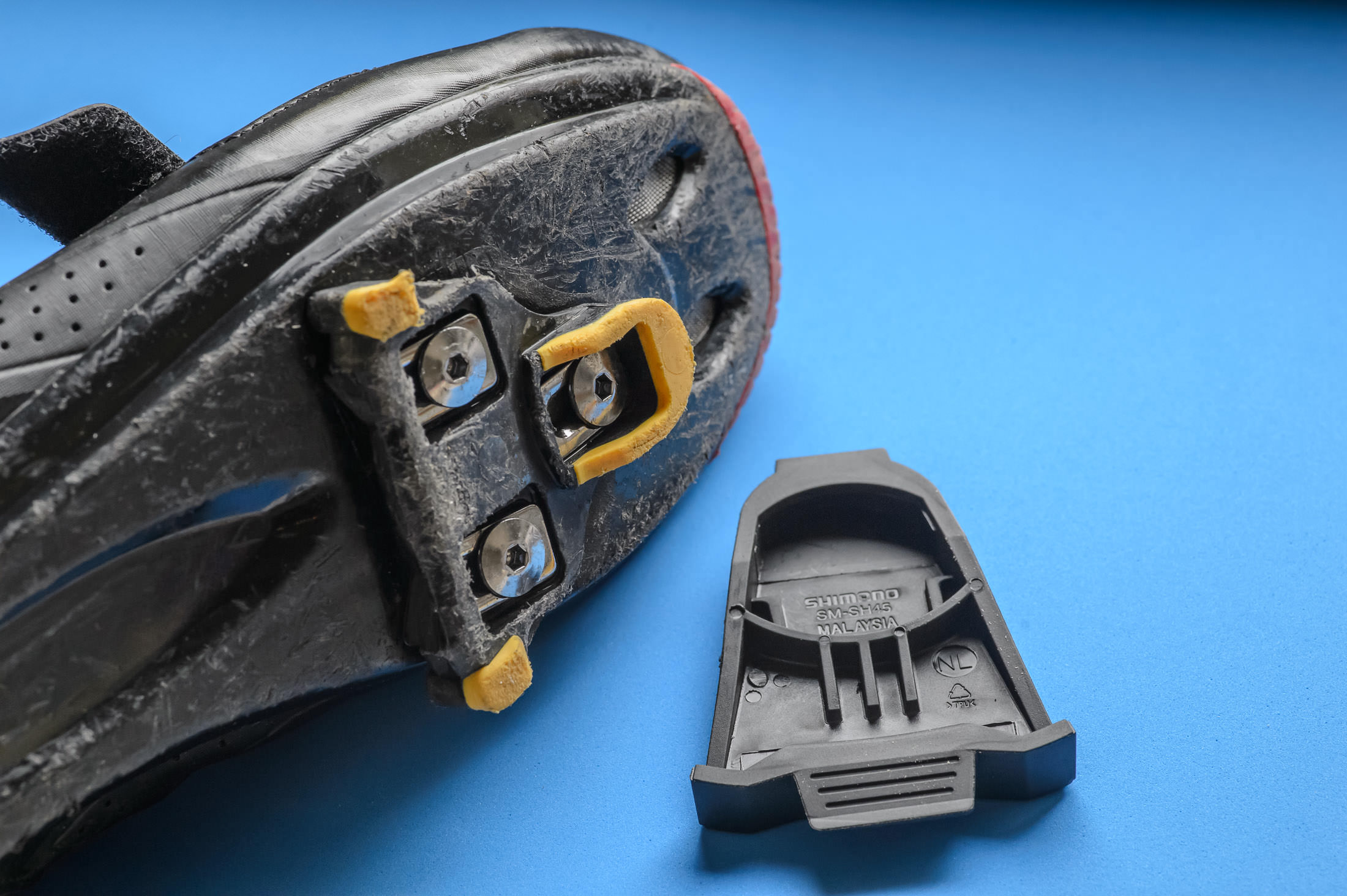
How not to Fall (at low speed)
Techniques to prevent low speed falls
In the previous article, we mentioned that many serious cycling injuries happen when cyclists are slowing and preparing to stop. So let’s discuss some techniques to prevent low speed falls.
Now all this may seem like a lot of effort. But it’s much preferable to broken bones! (As the old aged goes… you can say me now or pay me later!)
Cleats and Unclipping
How many times have you heard:
- “I couldn’t get unclipped and I fell”
- “My right leg was unclipped, but I leaned to the left and fell over”
There are several things you can do to pretty much eliminate these two reasons for falling!
Cleats and Their Maintenance
The market is dominated by two types of cleats:
- The small metal Shimano SPD type, which are commonly used for touring, mountain biking, and gravel riding. They are very durable, sit recessed in the shoe, and are easy to walk with. The SPD cleats look like this:

SPD Shoes and Cleats
- The Look Keo and Shimano SPD-SL types, which are large plastic cleats, commonly used for “performance” road riding. These cleats are exposed and easily worn and damaged by walking on them. The SPD-SL cleats look like this. Look Keo cleats are very similar. (Note the shoe cover!)

SPD-SL Shoes and Cleats
Here are some hints for preventing the dreaded “can’t unclip because the cleat is stuck” issue:
- Use SPD cleats! Really… they are much more durable, are easy to walk on, and tend not to get clogged by mud, dirt or stones. (That’s why mountain bikers and gravel riders, even competitive racers, use them)
- If you “must” use SPD-SL or Look cleats, put on shoe covers to protect them when walking in them. Inspect them regularly, and replace them at least once a year. Even slight nicks and wear on the front part of the cleat can cause it to get stuck.
- Keep the attachment tension on your pedals very loose, so it’s easy to unclip. Remember that SPD pedals are often two-sided and both sides need to have the tension adjusted. There is zero benefit to having the tension tight!
- Inspect your cleats after every ride, and clean out any dirt to stones that may have got caught around them
- Don’t oil or lubricate your pedals or clips! It won’t help with releasing from your pedal, and dirt will stick to the lubricant, potentially clogging the release mechanism.
Test That You Can Unclip Every Time You Start to Ride!
It’s a simple thing… when you get back on the bike after walking in your cycling shoes, test that you can unclip both feet. And test each foot twice! Better you know you have an issue when you are prepared for it, instead of when you have to make a quick stop! If things seem a little “off” try banging the bottom of your shoe against the pedal to dislodge any accumulated gunk, and test again. Often the act of clipping and unclipping a couple of times will help get rid of any issues.
Become an Ambidextrous Unclipper
Most people always put the same foot down, usually the right foot. We get so we favour that foot in an emergency, even if we are leaning the other way. We get so used to having the same foot down that using the other foot is very awkward and unnatural.
You have to train yourself to be equally comfortable with unclipping either foot. Otherwise, if you go to fall “the wrong way” you won’t be able to unclip in time to save yourself!
There is a simple drill to address this: Alternate which foot you use every time you stop. First time unclip and put your left foot down, next time use your right. Then your left. When I taught myself this, it took me 2 full weeks to get comfortable using either foot. So it will take time… keep at it. This is also a great attention and memory drill - you need to consciously control which foot you are putting down, and remember it so you can use the other foot next time!
Unclip before you need to
If you think you are going to be stopping, you can always unclip early. Better to discover you can’t unclip when you have a few seconds to try the other foot, try a few times, and have time plan your “escape” (see below)
When I’m off road riding, I will sometimes unclip when I see a very rough or problematic surface ahead… deep sand, mud, or large loose rocks. You will sometimes see pro road riders going this on slippery corners, anticipate they will need to stabilize themselves by putting their inside foot down.
Practice Slow Speed Riding
Balancing a bike at slow speed (or when stopped) is very different from balance when riding, and requires significant practice. Given that falling at low speed is so common, it’s really worth practicing! The best, and easiest, thing is to “play like a child” at slow speed riding. Just try stuff, practice riding slower and slower, practice making sharp turns while riding slowly. Ride slow standing and sitting. Can you stop for a second then continue to ride forward? Here are some specific drills:
- Tight turns at a walking pace: In a parking lot, within a single parking space, try to make a complete 360 degree circle while staying within the parking space. Don’t lean the bike, keep it parallel to the ground. Go as slow as you can. Try it standing up, as well as sitting down. Don’t worry if you can’t stay within a single parking space… the point here is to practice balance and turning at low speed.
- Stop and Go: Stand out of the saddle (it’s easier to balance out of the saddle). While riding slowly, use you brakes to come to a momentary complete stop without putting a foot down, then ride away again. It helps to be riding slightly uphill so the bike slows naturally. If you can’t come to a complete stop that’s OK… just try to make your “stop” slower and slower as you practice. If you ever feel yourself losing balance ride forward! Don’t try to put a foot down.
- Track Stand: This is a terrific balance drill! And, yeah, it’s pretty hard to learn as an adult. But that doesn’t mean you can’t practice it! This short video is very good How To Track Stand Like a Pro - YouTube Important! If you feel yourself losing balance - ride forward! Don’t try to put a foot down.
Losing Your Balance - Ride Forward!
The tendency when we lose our balance on our bike is to try to put a foot down. But it’s often better and safer to recover from an “incipient fall” by riding forward. Sometimes this is not an option… you obviously don’t want to ride out into traffic at a busy intersection! But often that’s not an issue. When it doubt, if it’s possible, just move forward. This requires some significant mental training, which we will talk about in a future article. The slow speed riding drills above will really really train you to avoid falls by moving forward to recover your balance.
Uneven Surfaces
Another common way to lose your balance is encountering a significant surface problem at low speed… a pothole, large crack, hitting a rock, a curb, etc. So practice! At a walking pace, ride off a curb. Find some big bumps in a parking lot and ride over them You will find that when you do this consciously, and at a walking pace, it will be easy to keep your balance. You trick is to practice enough so that when you have the issue unexpectedly when stopping or starting you will have the confidence to handle it.
If You Really Can’t Unclip!
So what if you really can’t unclip? This just happened to me. I was fitting cleats onto a new pair of shoes, and I went for a ride to test my cleat position without tightening the cleats on the shoes! So twisting my foot just twisted the cleat against the shoe… it was impossible to unclip either foot! (Yeah, that really was dumb!)
- Don’t panic! You need your head clear to make some decisions.
- Don’t stop! Ride as slow as possible. Look for a clear path you can ride. If you are at an intersection, make a right turn. Or maybe see if the road is clear enough to loop around. Just look for some space to keep moving slowly.
- While you are moving, you can work on trying to unclip… Eventually you will probably succeed.
- You can also look for something to lean against. Another rider, a signpost, a parked car. That will give you lots of time to work on getting a foot unclipped.
In my case, there were cars coming that prevented my from turning into my driveway, so I kept riding slowly until the road was clear, then I turned around and rode back to my driveway. Next I found a wall to lean against so I could stop. Then I leaned over and undid a shoe, so I could get my foot out and put it down. Phew! Then undo the other shoe so I could get off the bike. Now I could take my time to figure out how to get my shoes out of my pedals!
